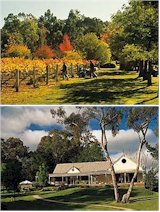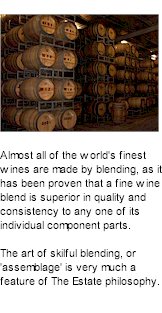


The mountain range was named by the noted explorer and surveyor Major Thomas Mitchell, for its raw beauty and similarities to the Pyrenees in south western France, where Mitchell had served as a young Army officer. The first grower of vines for winemaking in the Avoca area was a man named MacKereth, who planted his vines in 1848. His vineyards grew to supply the thirsty miners working in the then thriving old mining industry.

Over the years, Blue Pyrenees Estate has established a truly unique winestyle that captures the perfect balance between new world high technology and old world tradition. It is interesting that the lake depicted on the Blue Pyrenees Estate labels was originally the site of a gold mine, but on following a gold reef, miners struck an underground spring, which is now the source of a valuable water supply to the Estate.
It was in the early 1960's that the area was recognised for its potential for premium quality wine production with its unique combination of deep gravely soils and cool climate conditions. Following considerable development and experimentation the initial release under the Blue Pyrenees label was the 1982 Blue Pyrenees Estate Reserve Red. The rest, as they say is history.
The painting on the label is reproduced from the original oil painting by the respected artist Lorrie Banks. It depicts moonlight over the vineyards and was painted in 1985 and represents the Estate signature.

The factors determining terroir are primarily climate, geology and hydrology or soil water relations. The Blue Pyrenees Estate in the Pyrenees of Central Victoria was selected because these factors could be identified in a specific combination ideally suiting premium quality wine production. Research conducted by viticulturists and CSIRO of Australia demonstrates that Blue Pyrenees Estate consistently reaches maturity ten days after Coonawarra, a key reference for cool climate viticulture in this country.
Blue Pyrenees Estate is also the coolest in the Pyrenees region, with a diversity of microclimate and soils enabling each clone, and each variety to be planted in the best situation. The vineyards have been planted along the foothills facing north, at an altitude of 400 metres. Rainfall averages around 630mm, the pattern in most seasons being ideal - mainly in winter and early spring.
Red sandstone, old grey gravel and colluvium of pure loam. Each grape variety and its chosen clone is painstakingly selected and planted in suitable soils and within the appropriate micro climate. Cabernet Sauvignon, Shiraz and Merlot were planted, specifically in order to produce a superior house style, blended red wine. Several clones of Chardonnay are planted in selected sites to produce a flavoursome white wine and in other sites, for fine sparkling wine production. Pinot Noir and Pinot Meunier were also planted in these ideal Pyrenees cool climate conditions. In fact, the Estate now has the largest plantings of Pinot Meunier in Australia.
Sauvignon Blanc and Semillon are also grown on the property. Petit Verdot is now planted, as is Viognier the premiere varietal of Condrieu in France. These fine quality grape varieties are planted in vineyards totaling 185 hectares or some 460 acres, making it the largest single Estate investment in the premium Pyrenees winegrowing region.
